Around the Neighborhood - Volume 1, Number 10
In 1973, Family Communications initiated a print newsletter titled Around the Neighborhood. This newspaper-like publication was largely directed towards parents but included some material for children as well. The information below documents the tenth issue.
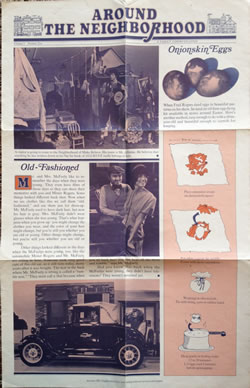
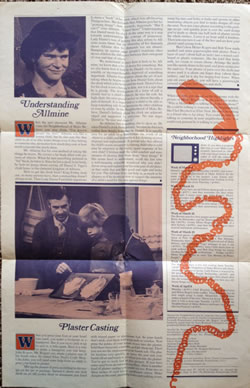
[click images for larger view]
Articles included:
- "Mr. Allmine image"
- Old-Fashioned
- Onionskin Eggs
- Understanding Allmine
- Plaster Casting
- "Who is Mister Rogers Talking To?"
- Neighborhood Highlights
Articles
A visitor is going to come to the Neighborhood of Make-Believe. His name is Mr. Allmine. He believes that anything he has written down in his big fat book of ALLMINE really belongs to him.
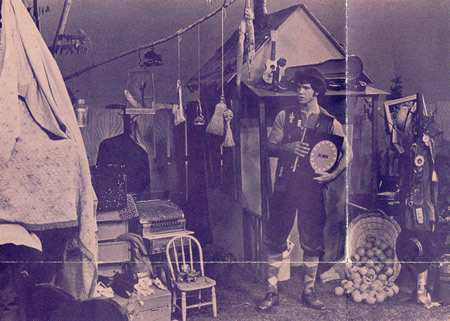
Mr. and Mrs. McFeely like to remember the days when they were young. They even have films of those days so they can share their memories with you and Mister Rogers. Some things looked different back then. Now when we see clothes like this we call them "old-fashioned," and use them just for dress-up. Mr. McFeely used to have dark brown hair, but now his hair is gray. Mrs. McFeely didn't wear glasses when she was young. That's what happens when you grow up: you might change the clothes you wear, and the color of your hair might change, but you're still you whether you are old or young. Other things might change, but you're still you whether you are old or young.
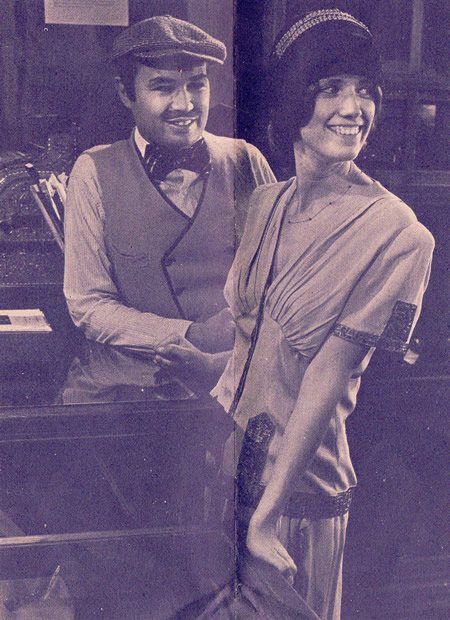
Other things looked different in the days when the McFeelys were young, too, like the automobile Mister Rogers and Mr. McFeely are riding in here. Someone took very good care of this car, so it still runs today, many years after it was bought. The seat in the back where Mr. McFeely is sitting is called a "rumble seat." "They must call it that because when you sit back here you can hear all the noise and rumble," says Mr. McFeely.
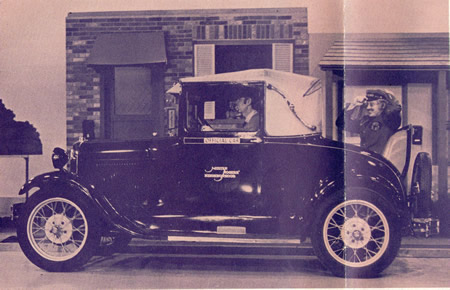
Did you know that back when the McFeelys were young, they didn't have televisions? They weren't invented yet.
When Fred Rogers dyed eggs in beautiful patterns on his show, he used an oil-base egg-dying kit available in stores around Easter. Here's another method, easy enough to do with a three-year-old and beautiful enough to varnish for keeping.
- Place onionskin scraps on cheesecloth square.
- Put white eggs in the middle. Cover with more onionskins.
- Wrap egg in cheesecloth. Tie with string, yarn, or rubber band.
- Drop gently in boiling water 12 to 20 minutes. Let eggs cool 5 minutes before unwrapping.
When the new character Mr. Allmine visits the Neighborhood of Make-Believe, you may think, "I've known people like that!" Allmine acts like a young child, but he also acts like that child in all of us who wants things even if they belong to someone else, no matter how much they cost or how much someone else needs them.
Mr. Allmine has his own method of taking the things he wants. He carries a fat book filled with picture of objects. When he sees something pictured in "his" book, he takes it. Since he has a clock in his book, he feels no pangs about carting off Daniel S. Tiger's clock home to his cluttered kingdom of Allmine.
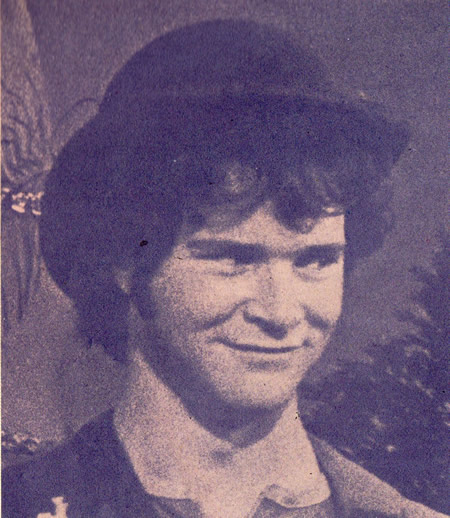
How to get the clock back? King Friday finds out, as many parents have, that commanding doesn't always work. Then Lady Elaine Fairchilde ingeniously starts a "book" of her own, which lists all Growing Things as hers. She demands that Allmine give her his "growing things" -- hair, toenails, fingernails. "But I can't!" cries Allmine. "I need them!" Understanding that Daniel needs his clock in the same way is a step towards understanding the concept of possession. Lady Elaine's way of getting this idea across to Allmine seems blunt, but the absurdity of her demands shows Allmine that his demands too are absurd. Bumping up against other people's reactions often shows children the difference between their own point of view and that of others.
We understand at once how it feels to be Allmine; we know that ache of desire for something. But we also know how it feels to be Daniel -- to be unreasonably or incomprehensibly deprived of something important. Allmine learns more about the art of not-taking when he begins to see how Daniel feels about the clock which is his home and his work. Daniel's love for his clock is not a luxury to him, nor is it a sign that he is greedy. The development of a sense of self is closely tied to a child's objects; he sees his crib, his high chair, his own special jacket as almost literally a part of himself. It is important to a child to be able to keep something safe from invasions by other children or even by adults. In the Neighborhood of Make-Believe, Daniel's feelings about his clock are acknowledged and supported by everyone. No one urges Daniel to "be nice and share it."
So Allmine has something else to show us. He takes Daniel's clock thoughtlessly, because he does not realize how deeply it matters to Daniel. It is equally easy for an adult to underestimate the worth of an object to a child, and to remove it for cleaning or even disposal and replacement. A parent who has offered his child's warm sweater to a visiting child who is cold may be surprised at the angry, upset response of his own child! Children need the solid comfort and reassurance of identity they draw from "their things." If this seems hard to understand, recall the last time a well-meaning someone wondered why you didn't throw away and replace your favorite pair of old shoes, or that outfit that just feels good and right and lucky for you. The Allmine in us can help us as much as he plagues us if he shows us how to respect the intensity of a child's need for his own special things.
When you press your foot or your hand into sand, you make a footprint or a handprint. But if you try to pick it up to save it, it falls apart. Here is a way to make a handprint you can keep. John Rogers, Mr. Rogers' son, made a plaster cast of his hands when he visited Elsie Neal's Craft Shop. Like John, you will need some help from an adult to print your hand in plaster.
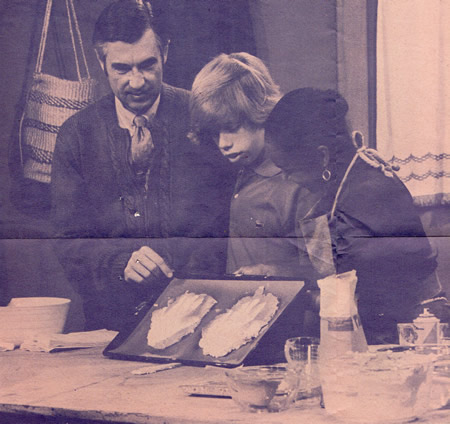
Mix up the plaster of paris according to the recipe on the jar or package. Spread it about one inch thick on an old cookie sheet or aluminum pan lined with waxed paper or aluminum foil. So your hands don't stick, coat them with soap suds or vaseline. Now press the palms of your hands down into the plaster, hold them there only a minute, and lift them out. There you can see the impressions your hands left. The plaster hardens very quickly, so have the pan and your hands all set and ready to go when you mix the plaster. You've got to work fast at this project. If you have some sand from an outdoors sandbox, there is another kind of plaster casting you could try too. Pour two or three inches of sand into a cardboard carton. Make designs in the sand, punching holds and making rivers, using big nuts and bolts or forks and spoons or other interesting objects you find to make designs all over the sand. Now mix some plaster according to the package recipe, and quickly pour it over the sand design you've made so about one half inch of plaster covers the whole surface. Leave it an hour until it hardens. Then you can turn it out of the box and see how your plaster sand casting looks.
Here's how Mister Rogers and Bob Trow made seashell and stone paperweights with plaster. Pour a layer of sand (about half an inch) into a waxed cardboard or plastic container, like the kind that holds milk, ice cream or cream cheese. Arrange the shells you like upside down in the sand, and press stones into the sand too. Pour plaster of paris over the shells and stones until it is about one finger deep (about three inches), and let it dry for twenty-four hours. When you cut away the box, you will have a paperweight covered with your best stones and shells.
"WHO IS MISTER ROGERS TALKING TO?"
When one little girl opened up the big poster with the picture of Mister Rogers on it, she asked her mother, "Who is Mister Rogers taking to on the telephone?" He could be talking to someone in his Neighborhood, like Chef Brockett or Elsie Neal. He could be talking to a friend who is far away. You could pretend he is talking to someone in your neighborhood, too. You could even pretend he is talking to you.
Note: If you miss a program that you or your child is particularly interested in, check with your local station to see when it will be repeated. Give them the program number.
Week of March 4
Daniel's clock disappears Monday (#466), and a new-comer in the Neighborhood of Make-Believe by the name of Allmine is the suspect. Lady Elaine uses some of her own brand of mischievous wisdom to help Daniel retrieve his clock Thursday (#469).
Week of March 11
The McFeelys have an old Edison phonograph to show Monday (#471), and they remember the days when they bought it many years ago. John Rogers, Mister Rogers' younger son, visits Elsie Neal's Craft Shop and makes a plaster casting of his hands Tuesday (#472). Friday King Friday unveils this new statue (#475), and the McFeelys celebrate their anniversary with surprise gifts for one another.
Week of March 18
The Browns practice their puppet performance of "The Elves, the Shoemaker's Wife" Monday (#476). Friday Mister Rogers shows a film of a shoe factory (#480), and then the Browns give their musical marionette performance.
Week of March 25
The street games children play on Francois Clemmons' block in New York are shown on a film Monday. Wednesday there is a fire in the Neighborhood of Make-Believe, and Handyman Negri manages to put it out (#483). Thursday (#484) Julia Child shows how to cook without a stove and Bob Dog brings his friend Smokey the Bear to talk to Henrietta. Friday (#485) Mister Rogers begins to read "The History of Planet Purple."
Week of April 1
The McFeelys have a live own visiting them Tuesday (#487) and the Neighbors of Make-Believe talk about cheating when you're racing. Lady Elaine is honored by the people of Planet Purple Wednesday (#488) and learns that they have decided to name their planet after her, the woman who helped them discover how nice different things can be.
Week of April 8
Monday (#491) Chef Brockett helps the McFeelys and Mister Rogers make waffles. They also see a film on how maple syrup is made. Meanwhile, Lady Elaine makes a batch of her own "Hurry-Up Syrup" and advertises it with a neon sign Tuesday (#492). Friday the Neighborhood of Make-Believe celebrates their Potato Harvest Festival (#495).
Credits
Around the Neighborhood and the materials that accompany it are published ten times a year by Family Communications Inc., a not-for-profit Pennsylvania corporation. Mr. Rogers' Neighborhood is funded by grants from the Sears Foundation and the Corporation for Public Broadcasting.
Around the Neighborhood is created for FCI by Media Projects Incorporated of New York. Subscription printing and distribution accomplished by Multiscope, Inc., Pittsburgh, Pennsylvania.
Executive Editor: Sara Stein
Editor: Susan Tyler Hitchcock
Assistant Editor: Barbara Staib
Editorial Consultant: Hedda Sharapan
Psychological Consultant: Dr. Margaret McFarland
Production Supervisor: Jim Macandell
Graphic Designer: Tobias O'Mara
© 1974, Family Communications Inc.
